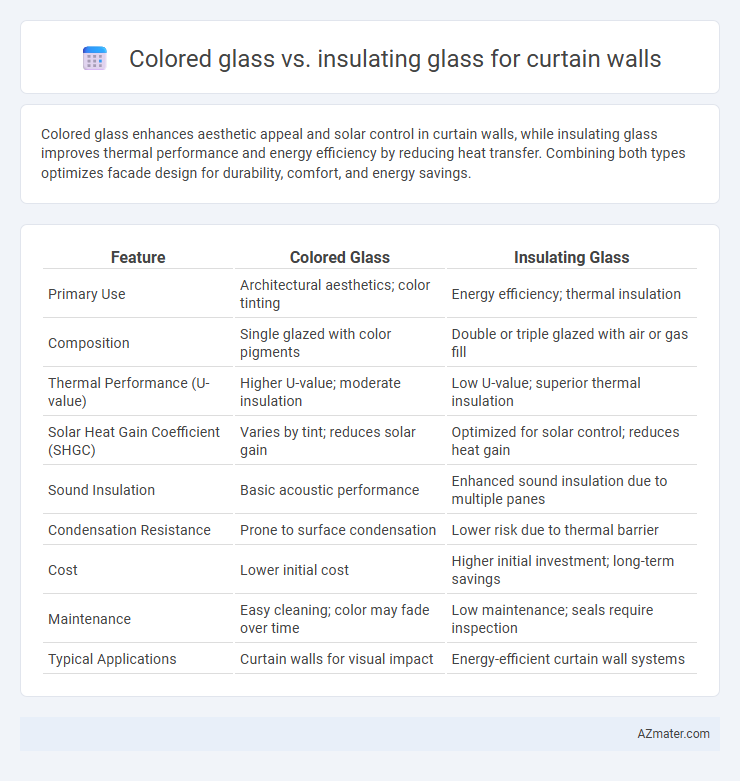Colored glass enhances aesthetic appeal and solar control in curtain walls, while insulating glass improves thermal performance and energy efficiency by reducing heat transfer. Combining both types optimizes facade design for durability, comfort, and energy savings.
Table of Comparison
| Feature | Colored Glass | Insulating Glass |
|---|---|---|
| Primary Use | Architectural aesthetics; color tinting | Energy efficiency; thermal insulation |
| Composition | Single glazed with color pigments | Double or triple glazed with air or gas fill |
| Thermal Performance (U-value) | Higher U-value; moderate insulation | Low U-value; superior thermal insulation |
| Solar Heat Gain Coefficient (SHGC) | Varies by tint; reduces solar gain | Optimized for solar control; reduces heat gain |
| Sound Insulation | Basic acoustic performance | Enhanced sound insulation due to multiple panes |
| Condensation Resistance | Prone to surface condensation | Lower risk due to thermal barrier |
| Cost | Lower initial cost | Higher initial investment; long-term savings |
| Maintenance | Easy cleaning; color may fade over time | Low maintenance; seals require inspection |
| Typical Applications | Curtain walls for visual impact | Energy-efficient curtain wall systems |
Introduction to Curtain Wall Glazing Options
Curtain wall glazing options primarily include colored glass and insulating glass, each serving distinct functional and aesthetic purposes. Colored glass enhances building facade design by adding visual appeal and reducing solar heat gain through tinted coatings or embedded colorants. Insulating glass, often double or triple-pane units filled with inert gases, improves thermal performance by minimizing heat transfer and boosting energy efficiency in curtain wall systems.
What Is Colored Glass?
Colored glass refers to glass that has been tinted or coated with various pigments to achieve specific hues and visual effects, enhancing aesthetic appeal in curtain wall systems. This type of glass helps control solar heat gain and glare while providing vibrant, customizable facades. Unlike insulating glass, which primarily focuses on thermal performance with multiple panes and gas fills, colored glass emphasizes visual design and light modulation.
What Is Insulating Glass?
Insulating glass, often used in curtain wall systems, consists of two or more glass panes separated by a spacer and sealed to create an air or gas-filled space, significantly enhancing thermal performance and reducing heat transfer. This type of glazing offers superior energy efficiency compared to colored glass, which primarily serves aesthetic purposes without substantial insulation benefits. Incorporating insulating glass into curtain walls improves building comfort, reduces HVAC costs, and contributes to sustainable design by minimizing energy consumption.
Aesthetic Differences: Colored vs. Insulating Glass
Colored glass in curtain walls offers vibrant hues and enhanced visual appeal by incorporating pigments or coatings that alter transparency and reflectivity, creating unique facades with dynamic light effects. Insulating glass, primarily designed for thermal efficiency, provides a more neutral appearance with low-emissivity coatings that maintain clarity while improving energy performance, often resulting in subtle color shifts like blue or green tints. The aesthetic differences lie in colored glass's bold, customizable tones versus insulating glass's understated, functional clarity, balancing design creativity with energy-conscious transparency.
Thermal Performance and Energy Efficiency
Colored glass in curtain walls reduces solar heat gain by selectively filtering visible and infrared light, improving thermal performance and lowering cooling loads in warm climates. Insulating glass units (IGUs) consist of multiple glass panes separated by a sealed air or gas-filled space, significantly enhancing thermal insulation and reducing heat transfer across the building envelope. Combining colored glass with high-performance insulating glass optimizes energy efficiency by balancing solar control and thermal resistance, resulting in lower HVAC energy consumption and improved occupant comfort.
Light Transmission and Solar Control
Colored glass in curtain walls reduces light transmission by absorbing specific wavelengths, offering moderate solar control but often compromising natural daylight penetration. Insulating glass units (IGUs) consist of multiple panes separated by air or gas layers, enhancing solar control by minimizing heat transfer while maintaining higher visible light transmission than colored glass. Combining low-emissivity coatings with insulating glass further optimizes energy efficiency, balancing daylight access and solar heat gain reduction.
Sound Insulation Capabilities
Colored glass in curtain walls offers moderate sound insulation but primarily enhances aesthetic appeal and solar control rather than acoustic performance. Insulating glass, composed of double or triple glazing with an air or gas-filled gap, significantly improves sound insulation by reducing external noise transmission through the curtain wall system. The inclusion of laminated layers or acoustic interlayers in insulating glass further enhances noise reduction, making it the preferred choice for urban or high-noise environments.
Cost Comparison of Colored and Insulating Glass
Colored glass for curtain walls generally has a lower upfront cost compared to insulating glass due to simpler manufacturing processes and fewer material layers. Insulating glass incorporates multiple panes and gas fills, increasing both production and installation expenses but offering superior thermal performance and energy savings over time. The initial higher investment in insulating glass often results in reduced operational costs, making it a cost-effective choice for long-term building efficiency.
Durability and Maintenance Considerations
Colored glass in curtain walls offers enhanced aesthetic appeal but may suffer from surface fading and coating degradation over time, requiring periodic inspection and touch-ups to maintain visual quality. Insulating glass units provide superior durability through multi-layer construction and sealed air gaps, reducing thermal stress and minimizing condensation issues, which leads to lower maintenance demands. Both types demand regular cleaning, yet insulating glass often necessitates fewer repairs due to its robust performance in energy efficiency and environmental resistance.
Choosing the Right Glass for Your Curtain Wall System
Colored glass enhances aesthetic appeal and can provide solar control by reducing glare and heat gain in curtain wall systems. Insulating glass units (IGUs) offer superior thermal performance through double or triple glazing, improving energy efficiency and sound insulation. Selecting the appropriate glass depends on factors such as climate, building orientation, energy codes, and desired visual impact, ensuring optimal performance and occupant comfort.

Infographic: Colored glass vs Insulating glass for Curtain wall
 azmater.com
azmater.com